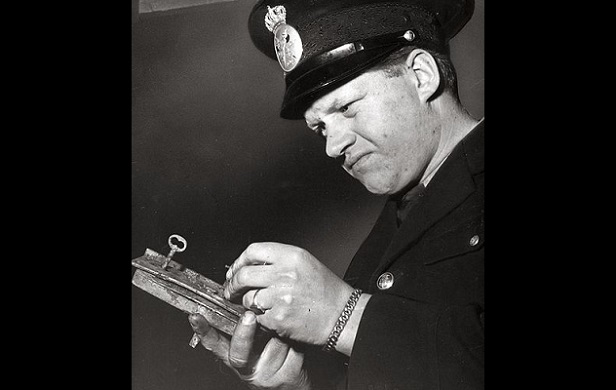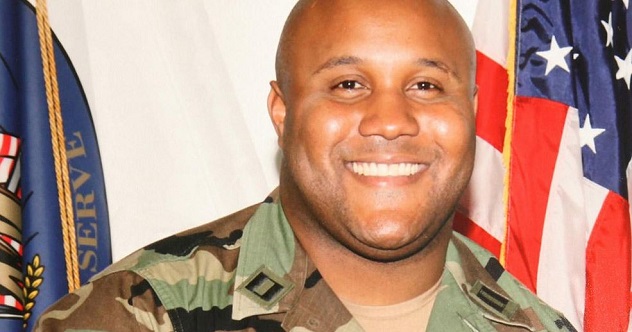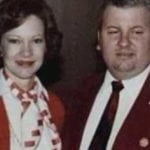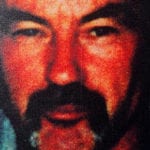Below, you will read about 10 prolific serial killers, all of whom were police officers. Some even investigated their own crime scenes, and they all abused their power and authority to carry out heinous crimes.
10 Tore Hedin
Most people don’t start a life of crime by stealing oats, but Swedish serial killer, arsonist, and police officer Tore Hedin did. When he was 16, he broke into a local brewery to steal some oats. Hedin then decided to burn the whole place down in order to cover his tracks. Eight years later in 1951, a rally was held in Hedin’s honor to keep him as the local police officer for the city. After the rally, he committed his first murder by killing his best friend, John Allan Nilsson, after a poker game. He then set fire to the crime scene. In an ironic twist, Hedin took part in the investigation of the murder he committed and even spoke to national media concerning the case. About a year after he killed Nilsson, Hedin went on a killing spree after his girlfriend, Ulla Ostberg, broke up with him. His first stop was at his parents’ house in Saxtorp. He killed them both, and then he set the house on fire. Afterward, he went to the retirement home where Ostberg worked and climbed through a window to her bedroom. When he didn’t find her in her room, he searched the floor and found Ostberg in the matron’s room. He killed them both with an axe, barred the doors, and set fire to the building. Four elderly people died in the home, and a fifth died later of burns in the hospital. After the spree, Hedin went into hiding. The local police agency had already realized he was behind the crimes, and they set out on a manhunt. They found Hedin’s car parked in front of a cabin by a lake, and a suicide note was on the front seat. In the note, Hedin claimed he was only good at tracking other criminals and explained that he killed his parents so they would not have to suffer for the crimes he committed. His body was later found weighted down in the lake.
9 John Christie
Serial killer John Christie should have never been a cop to begin with. He had a criminal record that included theft and violent assault, and he’d spent time in prison. But all of this was overlooked, and he was able to join the War Reserve Police, where his service was deemed highly efficient and credible. While serving as a policeman, however, he committed his first of many murders. Ruth Fuerst was a 21-year-old prostitute having an affair with Christie. He impulsively strangled her to death while having sex with her one night, and he then buried her in the communal garden of his residence at 10 Rillington Place. This ignited his desire to murder more women, and he settled on his neighbor, Muriel Eady. Christie invited her over on the false pretenses of being a doctor who could help with her chest ailment. Using carbon monoxide in an inhaler, he rendered her unconscious, then strangled and raped her before burying her body in the garden alongside Fuerst. Another neighbor, Beryl Evans, would become his third victim. Beryl and her husband, Timothy, wanted to end Beryl’s pregnancy, fearing they would be unable to support another child. Christie offered to help, again claiming to be a doctor. Instead, he raped and strangled Beryl with a necktie, then hid her body in the garden shed on the property. Christie reported to Timothy Evans that his wife died of septic shock, and claimed that he would find a suitable home for their one-year-old baby. The infant was later discovered with Beryl’s body in the garden shed. Evans, overcome with grief and wanting to protect Christie, actually confessed to killing his wife and child and was later hanged for the crimes. In the years to come, Christie would kill three more prostitutes and his wife, Ethel. He stored their bodies in various areas of the house. The three prostitutes would be discovered hidden in a papered-over alcove in the kitchen by a new tenant after Christie suddenly moved out. Ethel’s body would be discovered underneath the floorboards when police came to investigate. Christie was soon found in London and tried for his crimes. He originally entered an insanity plea, but with less than two hours of reflection, the jury ruled against him, sentencing him to hang for the murder of his wife. Christie was executed two weeks later on July 15, 1953.
8 Mikhail Popkov
Mikhail Popkov would use his uniform and patrol car to gain his victims’ trust before luring them to their deaths. From 1992 to 2000, Popkov targeted full-figured women who resembled his abusive mother, attacking them with a screwdriver, axe, or knife. He would then rape his victims before leaving their mutilated bodies in forests throughout the town of Angarsk, Russia. Popkov murdered at least 22 women, but the exact number could be well over 30. The brutality of the murders would haunt the townspeople and make national headlines, giving Popkov the nickname “The Werewolf” due to the violent nature of his attacks. But then the killings stopped. Popkov said he’d contracted a venereal disease that was left untreated and caused him to become impotent, leaving him unable to take pleasure from his murders and rapes. Popkov managed to elude detectives for two decades, even after one of his potential victims escaped and positively identified Popkov as her attacker. However, a mandatory DNA test was administered in 2012 for all law enforcement officials in Angarsk, thus identifying Popkov as the notorious Werewolf. In January 2015, Popkov was sentenced to life imprisonment.
7 Christopher Jordan Dorner
The catalyst to Christopher Dorner’s reign of horror began when he was released from the police force. He was let go after filing a report accusing another officer of extreme and unnecessary force during an arrest. He felt his release was unjustified, and in 2013 he set out to seek revenge on those he felt wronged him. The first two to be murdered by Dorner were Monica Quan and Keith Lawrence. They were shot up close while they were in their car. Neither had met Dorner before, but Quan’s father was an LAPD captain when Dorner was dismissed from the police force. Dorner admitted in his manifesto that he went after Quan’s daughter and her fiance because he didn’t think Quan did a good enough job defending him. Dorner posted his crazed manifesto to his Facebook page, detailing his grievances and listing those who would pay for them. This was just the beginning of nearly two weeks of eccentric antics and random killings that would leave four people dead and another two injured. After the posting of the manifesto, the LAPD reopened the case of Dorner’s release, and Chief Charlie Beck took to the media to assure Dorner they were serious about his demands to review his dismissal. In the meantime, however, police issued a manhunt and offered a reward for Dorner, believing him to be a domestic terrorist and a threat to society. During this time, he ambushed and killed Officer Michael Crain and injured his partner while they were on a routine patrol. On February 12, 10 days after Dorner’s crazed killing spree started, it all ended in a mountain cabin standoff with the police. Deputy Jeremiah MacKay was killed during a gunfight as Dorner stood his ground, opening fire as officers tried to smoke him out with tear gas. At one point, they heard a single gunshot from inside the cabin. Unintentionally, the tear gas set the cabin on fire and caused the ammunition inside to explode, making it unsafe for police to enter. Charred remains were removed from the cabin, and they were confirmed through dental records to be those of Christopher Dorner. The official cause of death was determined to be a self-inflicted gunshot to the head.
6 Tiago Henrique Gomes Da Rocha
Okay, security guards aren’t technically police officers, but they are people in authority. We trust them with our lives and well-being, so when one of them turns his back on the law, it can be truly terrifying. Take Tiago Henrique Gomes da Rocha for example. A Brazilian security guard, da Rocha would be dubbed one of the most prolific serial killers in the world. Claiming to have murdered to “relieve his personal pain and suffering” after being sexually abused as a child, da Rocha killed at least 39 people before he was finally caught in 2014. Targeting homeless people, homosexuals, and prostitutes who looked like his long-term girlfriend, da Rocha would approach people on his motorcycle before yelling, “Robbery!” He would then shoot his victims with a .38 revolver and drive away from the scene. For some reason, however, he never once stole anything from them. Eventually, police pulled da Rocha over for having fake plates on his motorcycle. This ultimately led to his capture. The house where he lived with his mother was searched, and that’s where police discovered the revolver used in the murders. Da Rocha eventually gave a full confession to police while in custody, and he’s currently waiting for his trial to begin.
5 Zeng Kaigui
Withdrawing large sums from banks is quite a common thing in China, as cash is by far the most accepted payment in the country. Serial killer Zeng Kaigui targeted his victims as they left with cash, shooting them and running away with their money. Zeng Kaigui served as a police officer in the People’s Liberation Army and was an expert in surveillance. This training allowed him to be a recluse who kept to himself and rarely interacted with anyone. And when he did, he usually communicated with just body language and grunts. It also helped him elude police officers when they first became aware of his robbing and killing in 2004. However, in 2012, he was identified outside a Nanjing bank after shooting a man and making off with about $30,000. Believing he was responsible for six other deaths and two injuries in similar crimes, authorities sent 13,000 police officers and two helicopters after Kaigui. However, he was never found, and it’s possible he could commit another robbery in the future.
4 David Stephen Middleton
Former Miami cop David Stephen Middleton used his new profession as a cable installer to find his victims. However, he never used his police knowledge to keep from being captured. In February 1995, the body of Katherine Elizabeth Powell was discovered bound in garbage bags and rope in a Reno, Nevada, trash dumpster. Middleton was a prime suspect because he made a service call to Powell’s home days before she was murdered. Even more damning, he used her credit card to purchase stereo equipment, and then sent his roommate to pick it up for him. The killer also used a very specific yellow trash bag to cover Powell’s body. These bags were only sold in two stores in Middleton’s area. Upon the issue of the search warrant, police discovered the trash bags, stereo, and numerous other incriminating items in a storage unit that Middleton rented. In September of the same year, the remains of Thelma Davila (last seen in 1994) were found in a similar fashion as Powell’s, indicating Middleton had killed Davila before murdering Katherine. A blanket belonging to Davila had been found in Middleton’s storage locker, and a hair found in the unit was positively identified as Davila’s. Also, a bus driver who was familiar with Davila had dropped her off on the last night she was seen, and he watched her get into a truck with a man who fit Middleton’s description. With the evidence mounting against him, police arrested Middleton. After a trial in 1996, he was accused of two counts of kidnapping and grand larceny, in addition to two counts of murder. Middleton was found guilty and sentenced to death. While in prison, the remains of another body were found in an apparent body dump. Middleton is one of the suspects in the case, and FBI officials are asking for help in identifying the woman.
3 Anthony ‘Jack’ Sully
After eight years of service, Anthony “Jack” Sully left the Millbrae City Police Department and started an independent contracting business. His business would quickly become successful, and Sully began freebasing cocaine and hiring escorts, preferring the girls who worked for Tina Livingston. In February 1983, Sully committed his first of six heinous murders. He had Livingston bring Gloria Fravel to his company warehouse, and after Fravel denied Sully’s advances, he gagged and handcuffed her. He then suspended her from the ceiling and raped her repeatedly over the weekend, with Livingston and another prostitute’s assistance. Eventually, Fravel’s gag became loose, and she screamed for help. That’s when Sully tightened the noose suspending her until her body went limp. Thinking she was dead, they loaded her in the car to dispose of the body, but upon unloading, they realized she was still alive. Sully then hit her with a hatchet repeatedly until she died. Her body was found later, and Sully kept the newspaper article detailing the investigation, thinking it humorous that Fravel was discovered by a butcher. Two months later, Sully killed another of Livingston’s prostitutes, 19-year-old Brendan Oakden, in a very similar fashion. Only this time, he stored her body in a barrel before disposing of it. A month later, he murdered another prostitute and her pimp, Phyllis Melendez and Michael Thomas, respectively. Once again, he stored their bodies in barrels. A fourth prostitute named Barbara Searcy was his next casualty, and his final known victim was Kathryn Barrett, bringing his total to six. Sully was arrested in August 1983, with an overwhelming amount of evidence stacked against him. Not only were materials used to dispose of the bodies found in both his truck and warehouse, but his footprint was captured on plastic sheeting used to cover Searcy and Barrett. His fingerprints were also found on the barrels used to enclose Oakden, Melendez, and Thomas. And in addition to numerous testimonies of prostitutes who were abused by Scully, Livingston testified against him pursuant to a plea agreement. After a seven-week trial, Sully was convicted and given the death penalty in June 1986. His appeal of both the convictions and the death penalty was denied in 2013, leaving him few options for an overturn.
2 Gennady Mikhasevich
Gennady Mikhasevich was a volunteer police officer (or druzhinnik) for the Voluntary People’s Druzhina in the USSR. He was often assigned to work the cases of his own murders, conducting interviews and handling evidence. From 1971 to 1985, Mikhasevich killed a confirmed 36 women, but the total could actually be nearer 55. He often raped and strangled his victims, but he let other men take the fall for his crimes. Tragically, 13 people were convicted in his place, 12 of whom were sent to labor camps. And one unfortunate soul was shot . . . after being forced into confessing by torture and threats. However, investigators later realized that the killings must’ve been committed by one person as they were all similar in execution. With the serial killer theory in mind, Mikhasevich began worrying he would be captured. So he sent an anonymous letter to the police signed “Patriot of Vitebsk,” stating the corruption of the times was the cause of the killings. This actually gave the police a lead, and after another note was left next to a new victim, police decided to compare the letter to the handwriting of over 500,000 males in the city of Oblast. They came upon Mikhasevich’s sample and combined it with other evidence to conclude that he was the serial killer. While he confessed and was arrested, Mikhasevich’s fate isn’t clearly known. Some reports say he committed suicide in jail. Others say he was executed by firing squad. But one thing for sure is that his capture revealed the incompetence and corruption of the police force in the USSR at the time. He was also the first serial killer acknowledged by the state-controlled Soviet media.
1 Norbert Poehlke
One could say Norbert Poehlke’s string of murders began as a crime of passion. A veteran police officer, Poehlke’s daughter passed away from cancer in March 1984, leaving the family with around $400,000 in debt. But while he wanted to provide for his loved ones, things quickly spiraled out of control. From May 1984 to October 1985, police noticed a pattern in bank robberies occurring in West Germany. The assailant would break the teller window with a sledgehammer. After demanding money, he would then escape in a stolen vehicle. The owner of the getaway vehicle would then be found dead—shot in the head—in an area near the bank. This occurred at least three times, and police were now on the lookout for a serial attacker. After the last robbery, which was unsuccessful, police identified the gun as a Walther P5 pistol, a gun commonly issued to police. Investigators then discovered the police uniform of Norbert Poehlke in a locker at the Ludwigsburg train station. Pairing this with Poehlke’s recent strange behavior, his daughter’s death, and his large debts, police decided to pay him a visit to ask a few questions. Sadly, though, they were too late. Fearing the police were onto him, Poehlke took sick leave, went home, and shot his wife and one of his sons. Poehlke then disappeared with his other boy, but police soon found their bodies in northern Italy. Both were shot in the head with the Walther P5 in what was clearly a murder-suicide. Ballistics would further conclude that Poehlke was involved in all three robberies and shootings, indicating the case was closed. Tracy spends her days writing and designing in a tourist town where she lives with her dog.
























